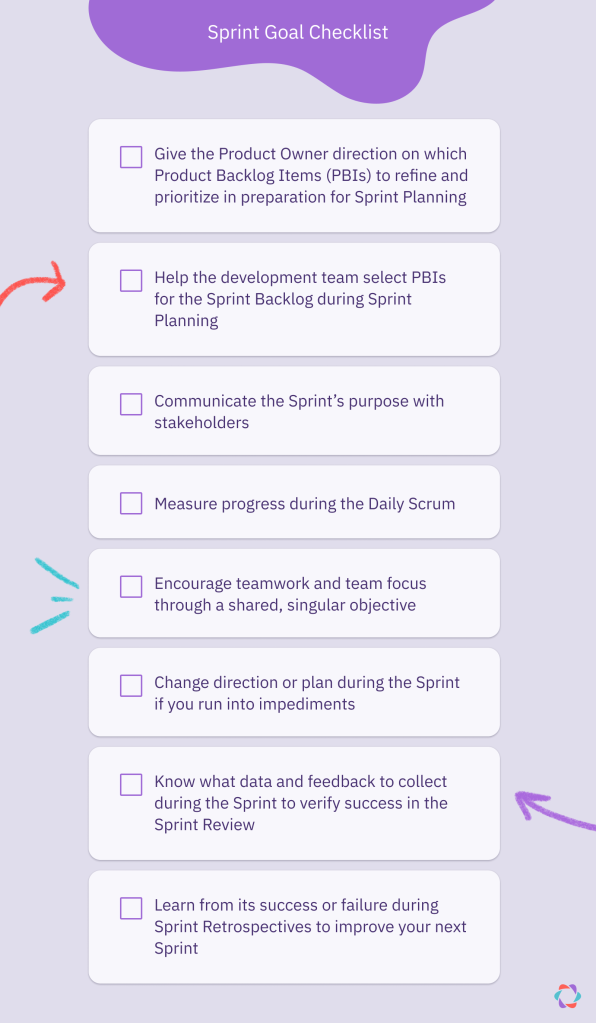How to Write and Use a Sprint Goal (With 5 Templates)

Creating effective Sprint Goals is like writing clues for a scavenger hunt. Make them too detailed, and you kill the fun. Provide insufficient guidance, and nobody finds the treasure. Besides striking that tricky balance, you may find that you need to write your Sprint Goal in a hurry, minutes before the hunt starts.
Drafting a Sprint Goal never seems like the highest priority at the end of one sprint and the beginning of another. Yet an effective Sprint Goal can make or break your Sprint.
In this article, we’ll show you how to write a great Sprint Goal for your team. We’ll cover:
- What is a Sprint Goal?
- Setting a Sprint Goal: Who, when, and where
- Sprint Goal templates
- The 6 characteristics of a highly effective Sprint Goal
- Sprint Goal checklist
What is a Sprint Goal?
A Sprint Goal is a short statement that gives your Sprint purpose, direction, and focus. It is often written by the Product Owner and helps the Scrum team with prioritization, progress measurement, and decision making in all Scrum events, including Sprint Planning, the Daily Scrum, Retrospectives, Sprint Reviews, and during the Sprint itself.
An Agile incarnation of baseball legend Yogi Berra“You’ve got to be very careful if you don’t have a Sprint Goal, because you might not get there.”
The development team focuses its efforts to achieving the Sprint Goal during the Sprint, which is usually timeboxed to 2 weeks. Usually, the aim is to deliver an increment – a working product update that solves a customer problem. You can also set a Sprint Goal to test an assumption or reduce risk, like addressing technical debt.
Here’s an explanation we’ve used in the past to show the Sprint Goal’s relation to other Scrum artifacts:
You can think about the Product Backlog as a map, with many attractive locations you could visit, but not in one trip (your Sprint). For each trip, you need to pick one destination (your Sprint Goal). To get there, you need a route (the Sprint Backlog) and turn-by-turn instructions (the work items in your Sprint Backlog, but also the user stories and acceptance criteria in each Sprint Backlog item).
Setting a Sprint Goal: Who, when, and where

- The Product Owner should prepare one or more draft Sprint Goals before the Sprint Planning meeting begins. This avoids a lot of wasted time in your Sprint Planning meeting trying to get consensus on what would make a good Sprint Goal.
- The Product Owner should share the draft Sprint Goal during the first part of Sprint Planning, or even asynchronously in advance. It is up to the Product Owner to explain why this objective will create customer value and to clarify how the goal serves the long-term vision and roadmap.
- You can tweak and change the Sprint Goal during Sprint Planning as you get a clearer picture of the upcoming Sprint, including what you’re going to work on and how. Note that the Product Owner should also receive input from developers so the Sprint Goal is something everyone can get on board with.
- As the Product Owner, you will give the Sprint Goal a final check at the end of the Sprint Planning event and make sure the tasks in your Sprint Backlog will help you achieve that goal. Ask everyone if they believe the shared goal is achievable. Then remind team members that the success of the Sprint is measured against the Sprint Goal.
- Now you can place the final Sprint Goal on your task board. For example, you may put it at the top of the Sprint Backlog or Ready column in your Scrum board. You can reference it there during Daily Scrums to measure progress and assess blockers according the objective.
Sprint Goal templates
You don’t need to start from scratch when drafting a Sprint Goal. Here are several handy Sprint Goal templates and frameworks you can follow.
The Scrum.org Sprint Goal template
Our focus is on <Outcome>
We believe it delivers <Impact> to <Customer>
This will be confirmed when <Event happens>
An example from their article of this template in action:
Our focus is on sending a basic email that contains a link to a spreadsheet. We believe it delivers confidence in the product to our organisation. This will be confirmed when we have an email in an inbox.
Roman Pichler’s Sprint Goal template
Roman Pichler, a product management expert, arguably has the most referenced Sprint Goal template on the internet – all links seem to lead to his.
It’s more work to complete than the Scrum.org template, but you’ll have a more detailed and fail-proof goal.
As you can see in the image above, Roman’s template is extensive. It requires you to fill out a goal, the method, and the metrics you’ll track. Source: https://www.romanpichler.com/.
The Scrum.org Sprint Goal example might look as follow using Roman’s template:
- Goal: Send a basic email that contains a link to a spreadsheet.
- Method: Deliver an email to testers and stakeholders from within our product. (The email can’t be a mockup or dummy solution that doesn’t work or scale in the actual product.)
- Metrics: Email delivery success, measured by clicks coming through in our reports.
The feature-advantage-benefit framework
Guy Maslen, a Scrum Master from New Zealand, defines a feature, advantage, and benefit in his Sprint Goals:
- Feature: The what from a stakeholder’s perspective.
- Advantage: Highlights the how – what makes this feature special.
- Benefit: Covers the why by defining the business outcome.
Guy gives this example of a goal based on this framework: “One-click creation of a PowerPoint from <panel display tool>, so you can easily share results with customers, saving time.”
The Sprint Goal as a newspaper headline
Agile coach Luke Salvoni suggests teams write their Sprint Goals as newspaper headlines. How would be the front-pages talk about your successful Sprint?
Luke says this helps make Sprint Goals short, snappy, and SMART – Specific, Measurable, Achievable, Relevant, and Time-bound.
An example of a goal-as-a-headline could be: “Team Raphael demonstrates feature XYZ shaving $100 off hosting costs per customer.”
The Sprint Goal as a Tweet
Our own rule of thumb – which you can combine with the other templates covered here – is that your Sprint Goal should fit in a Tweet. Ideally it should be no more than 140 characters. But you can push it up to 280 if you need to.
Here’s a Sprint Goals infographic you can share with your team to inspire them.

The 6 characteristics of a highly effective Sprint Goal
Now that you’ve drafted up your Sprint Goal, check it against these six points to make sure it will be effective.
1. It has purpose
Effective Sprint Goals state what you want to accomplish during your Sprint and why doing so is valuable.
By embedding purpose in your Sprint Goal, the team better understands what you’re trying to achieve and the expected outcome. They can then use that knowledge to propose better ways to reach that objective during Sprint Planning or find solutions when problems arise in the Sprint.
A Sprint Goal example with and without purpose:
- Without: Add bitcoin to the payment options at checkout.
- With: Add a free or low-cost payment method to the online checkout process, since 30% of customers abandon their shopping carts because of high transaction fees.
2. It considers the user or business
An effective Sprint creates customer value or positively impacts the business. You can ensure your Sprint Goal is delivering value by making the expected impact on the user or business explicit.
Ask these questions to test your Sprint Goal:
- After achieving this goal, what can users now do that they couldn’t before?
- Which part of the business does this Sprint Goal help, and in what way?
Beware of bland statements like “because it helps the marketing team” or “as it increases profit.”
Make your goal specific and meaningful instead, and ask for clarification from stakeholders if you can’t. Ambiguity leads to misunderstandings during the Sprint that can cause team members to push in different directions.
An example of a Sprint Goal with and without considering the user or business:
- Without: Expand shipping options with same-day delivery.
- With: Expand shipping options so that customers from any part of the country can enjoy same-day delivery, which will help grow revenue by 10%.
3. It specifies an outcome
Including a desired outcome makes the Sprint Goal binary. This helps you know without a doubt if the team achieved it. You either fulfilled the outcome, or you didn’t.
An outcome isn’t the same as output. The output reflects an action, whereas the outcome is a measured result.
An output goal is to A/B test the signup CTA button on a landing page to see which variation gives the highest conversion.
An outcome goal is to gain a total of 1,000 new customers through that same landing page, and a way to do so is by A/B testing the signup mechanism.
An example of a Sprint Goal with and without an outcome:
- Without: Improve the retention rate of our mobile app.
- With: Improve the monthly retention rate by 10% before the end of the year, so we have a large enough customer base to run statistically significant A/B tests.
4. It fears no failure
More experienced teams should consider setting ambitious Sprint Goals to speed up progress and learning. You won’t achieve some of those goals, and that’s okay.
Failure gives you data and insights you can learn from, as long as you:
- Think through in advance what it is you’re trying to learn and embed that aim in your Sprint Goal.
- Take the time to reflect on any failures during Sprint Reviews and Retrospectives.
Such learning leads to continuous improvement, an agile principle that’s an essential part of the Scrum framework. Learn and improve something every Sprint, and your performance and product quality can at least double.
An example of a Sprint Goal with and without fear of failure:
- Without: Increase traffic on our sign-up landing page.
- With: Double the number of weekly sign-ups on our landing page.
5. It sides with the team
The Product Owner brings one or more draft Sprint Goals to Sprint Planning, and the development team needs to embrace and – almost literally – run with the goal.
Trusting the team to plan how they do the work is an essential agile principle. This means they contribute and consent to the final wording of the Sprint Goal.
Now that’s Scrum theory. In reality, Product Owners – often under stakeholder pressure – might dictate a Sprint Goal. But once you cross – or rather burn – that bridge, you create a downward spiral that’s impossible to escape.
The team will not take ownership of a dictated goal. That’s why it’s important to make sure the team’s voice is represented in the final Sprint Goal.
An example of a Sprint Goal that sides with the team and one that doesn’t:
- Without: Any Sprint Goal the team hasn’t committed to.
- With: Any Sprint Goal the team commits to and understands.
6. It stays specific
A well-defined, targeted Sprint Goal essentially is a decision about what’s important in this Sprint and everything else that’s not.
To paraphrase Steve Jobs: A focused Sprint Goal isn’t just about saying yes to one thing but also no to a hundred other things you could be doing this Sprint.
This advice is easy to understand but hard to follow. Most Product Owners have many stakeholders, each with lists of high-priority items. You want to avoid bloated Sprint Goals that lead nowhere at best and often to disaster. One way of doing so is keeping Sprint Goals tightly defined and specific.
An example of a slim Sprint Goal and one that’s not:
- Without: Add features A, B, and C, plus try to address customer complaints X, Y, and Z if you have time left.
- With: Make sure feature A is built and released so we can collect usage data during the next Sprint that shows whether features B and C add value and should be developed.
Sprint Goal checklist
A well-crafted Sprint Goal is a helpful tool throughout your Sprint.
Here’s a final checklist of how effective agile teams put their goals to use.
Effective agile teams use their Sprint Goal to:
- Give the Product Owner direction on which Product Backlog Items (PBIs) to refine and prioritize in preparation for Sprint Planning.
- Help the development team select PBIs for the Sprint Backlog during Sprint Planning.
- Communicate the Sprint’s purpose with stakeholders.
- Measure progress during the Daily Scrum.
- Encourage teamwork and team focus through a shared, singular objective.
- Change direction or plan during the Sprint if you run into impediments.
- Know what data and feedback to collect during the Sprint to verify success in the Sprint Review.
- Learn from its success or failure during Sprint Retrospectives to improve your next Sprint.
Let’s end with Scrum.org‘s sum-up of the usefulness of having a Sprint Goal:
We cannot plan perfectly for the unknown… The Sprint Goal helps provide focus on an objective we want to achieve and allows the flexibility to negotiate the work to achieve that objective.
Feel free to use this Sprint Goal checklist with your team when setting Sprint Goals!










